The Gaura Guide
Gaura, also known as bee blossom, is a graceful perennial prized for its airy habit, long bloom time, and delicate, butterfly-like flowers. Native to North America, this drought-tolerant beauty adds movement and softness to garden borders, cottage-style plantings, and pollinator habitats. From soft whites to vibrant pinks, Gaura flowers dance above the foliage on slender, wand-like stems for months on end.
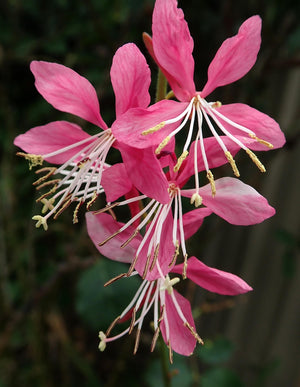
About
Gaura belongs to the Onagraceae family and is most commonly represented in gardens by Gaura lindheimeri, now often classified as Oenothera lindheimeri. These sun-loving perennials form bushy clumps or airy sprays of narrow green or reddish foliage, depending on the cultivar. The long-lasting flowers resemble butterflies fluttering in the breeze, and their blooming period can stretch from late spring until frost.
Standout varieties include Gaura lindheimeri 'Whirling Butterflies' with pure white blooms that sway above tall stems, and 'Rosy Jane', known for its striking pink-and-white bicolor flowers. Compact forms like 'Belleza Compact Pink' and 'Steffi Dark Rose' are well-suited for containers and small garden spaces. For consistent bloom and reliable performance, cultivars such as 'Sparkle White' and 'Stratosphere Pink Picotee' are garden favorites.
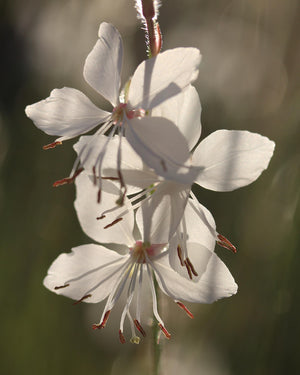
PLANTING
Gaura thrives in warm, sunny environments and tolerates a wide range of soils, making it easy to grow in many garden settings.
- USDA Hardiness Zones: 5–9, though it may overwinter as a short-lived perennial in colder climates.
- Soil: Well-drained soil is essential. Gaura is tolerant of poor, sandy, or gravelly soils.
- Sunlight: Full sun is ideal. Too much shade may result in floppy growth and fewer flowers.
- Spacing: Space plants 18–24 inches apart to allow air circulation and accommodate their spreading habit.
- Planting Time: Spring is best for planting to allow roots to establish before summer heat. Fall planting is also suitable in milder climates.
Loosen the soil and mix in compost or grit for drainage. Plant Gaura at the same depth as it was in the nursery pot, and water well to help it settle in.
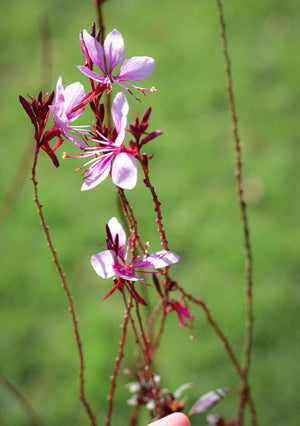
CARE
Once established, Gaura is low-maintenance and thrives with minimal attention.
- Watering: Water regularly when young, then reduce as the plant matures. Gaura is highly drought-tolerant once established.
- Fertilizing: Apply a light dose of balanced fertilizer in early spring. Avoid overfeeding, as this can reduce flowering.
- Deadheading: Optional but helps encourage more blooms. Snip spent flower stems to keep plants looking tidy.
- Pruning: Cut back to the base in late fall or early spring to rejuvenate growth. Plants may self-seed or spread by rhizomes.
- Pests & Diseases: Generally pest-free. Watch for root rot in heavy, poorly drained soils.
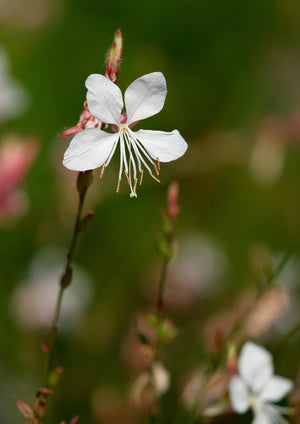
HOW TO USE
Gaura’s breezy elegance and pollinator appeal make it an excellent choice in many settings:
- Pollinator Gardens: A magnet for bees and butterflies, especially in native or naturalized beds.
- Cottage Gardens: The airy blooms of 'Ballerina Rose' and 'Passionate Rainbow' blend beautifully with coneflowers, salvia, and lavender.
- Borders & Mixed Beds: Adds vertical interest without overwhelming neighboring plants. Try pairing with ornamental grasses or yarrow.
- Containers: Compact cultivars like 'Belleza Dark Pink' and 'Steffi Blush Pink' work well in large pots or mixed patio planters.
- Wildlife-Friendly Landscapes: Gaura’s long blooming season and resilience make it a staple in low-maintenance, pollinator-driven designs.
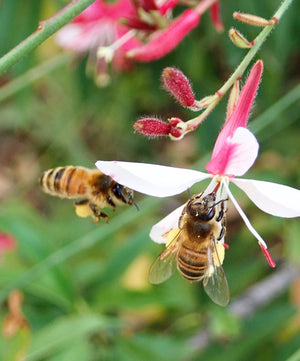
Common Questions
- Is Gaura deer resistant? Yes, Gaura is typically deer resistant due to its wiry stems and unpalatable foliage.
- Does Gaura spread? Gaura can self-seed modestly, and some varieties may spread by underground rhizomes.
- Is Gaura a perennial? Yes, Gaura is a herbaceous perennial in Zones 5–9, though it may act like a tender perennial in colder regions.
- Is Gaura toxic to dogs? Gaura is not known to be toxic to dogs.
- Is Gaura toxic to cats? Gaura is not considered toxic to cats.
- Do rabbits eat Gaura? Gaura is generally unappealing to rabbits.
- Can you propagate Gaura? Yes, Gaura can be propagated by seed, softwood cuttings in spring, or division in early spring or fall.
- Do you cut back Gaura in the fall? Yes, pruning in fall or early spring encourages dense new growth.
- How to care for Gaura? Provide full sun, well-draining soil, and occasional water once established. Cut back for shape and rejuvenation.
- How to plant Gaura? Plant in full sun with well-draining soil. Space 18–24 inches apart and water well during establishment.
Conclusion
Graceful and long-blooming, Gaura adds a touch of whimsy and lightness to the garden with minimal effort. Its floating flowers and easy-care nature make it ideal for sunny borders, mixed beds, or pollinator gardens. Whether you prefer the classic white of 'Whirling Butterflies' or the vivid pinks of 'Rosy Jane' and 'Ballerina Rose', Gaura’s carefree charm enhances landscapes from spring through frost.
The Gaura Collection
Sold Out
Sold Out
Sold Out
Sold Out
Sold Out






